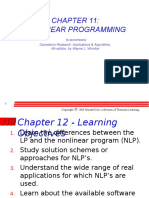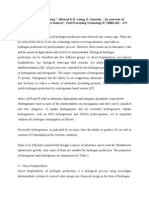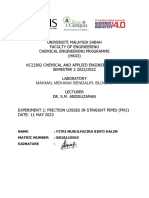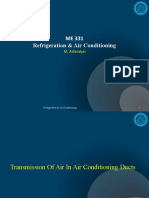Solved Problem 04
Uploaded by
DeGees Efosa AiguiSolved Problem 04
Uploaded by
DeGees Efosa AiguiK141 HYAE 1 exercise 4
Solved problems 4
th
exercise
Solved problem 4.1.
On a circular conduit there are different diameters: diameter D
1
= 2 m changes into
D
2
= 3 m. The velocity in the entrance profile was measured: v
1
= 3 ms
-1
. Calculate
the discharge and mean velocity at the outlet profile (see fig. 1). Determine also type
of flow in both conduit profiles (whether the flow is laminar or turbulent)
temperature of water T = 12 C
Figure 1
S o l u t i o n
Discharge Q and consequently velocity v
2
can be calculated from the continuity
equation.
1 3
2
2
1
1 1 1
s m 425 , 9
4
2
3
4
D
v S v Q
=
t
=
t
= =
1
2 2
2 2
2
ms 333 , 1
4 3
425 , 9
4 D
Q
S
Q
v
=
t
=
t
= =
To determine type of flow in conduit, the Reynolds number
v
=
D v.
Re will be used.
For laminar flow: 2320 Re<
For turbulent flow 2320 Re>
Kinematic viscosity of water of 12C:
1 2 6
. 10 24 , 1
= v s m (see Tab. 1)
For the conduit:
2320 10 . 1 , 4838
10 . 24 , 1
2 . 3
Re
3
6
1 1
1
> = =
v
=
D v
turbulent flow
2320 10 . 3225
10 . 24 , 1
3 . 333 , 1
Re
3
6
2 2
2
> = =
v
=
D v
turbulent flow
K141 HYAE 2 exercise 4
Solved problem 4.2.
A horizontal pipeline is attached to the wall of reservoir (see fig. 2). The pipeline has
different profiles. The water level in the upper reservoir is in the height H = 1.5 m
above the pipeline axis. From the lower end of the pipeline water flows out to the
open space. Diameters and lengths of pipeline reaches are: D
1
= 0.24 m, L
1
= 3 m,
D
2
= 0.1 m, L
2
= 1 m, D
3
= 0.12 m, L
3
= 2 m. Calculate discharge in the pipeline and
draw the course of energy line (EL) and pressure line (PL).
Resolve the problem:
a) Neglecting losses (i.e. consider the liquid to be ideal)
b) Considering losses for water of temperature 10C.
Steel pipeline consider to be after usage (slightly rusted).
Figure 2
S o l u t i o n
a) Neglecting losses
Bernoulli equation (BE) and continuity equation will be used to solve the
problem. Using BE to calculate discharge, it will be the most convenient to state the
datum (reference) level at the axis of the horizontal pipe, and to write then BE for the
upper water level (profile 0 pressure on the level is known - p
a
), and for the centre
of outlet profile 3 (its position, referred to the datum level, is h = 0). The upper
reservoir can be considered to be large (its dimensions are not mentioned because
they have no importance) and the effect of approach velocity u
n
can be therefore
neglected (i.e. v
n
= 0). Then:
BE 0 3:
g
v
g
p
g
v
g
p
H
a n a
2
0
2
2
3
2
+
+ = +
+
Arranging this equation, mean velocity in outlet profile can be calculated
1
3
. 42 , 5 5 , 1 81 , 9 2 2
= = = s m gH v
Mass discharge is calculated from continuity equation
1 3
2
3 3
. 061 , 0
4
12 , 0
42 , 5
=
t
= = s m S v Q
Now it is possible to use continuity equation again, to calculate velocities in other
profiles and to calculate thus also corresponding velocity heads.
1
2
1
1
. 356 , 1
24 , 0
061 , 0 4
=
t
= = s m
S
Q
v , m
g
v
094 , 0
62 , 19
356 , 1
2
2
2
1
= =
K141 HYAE 3 exercise 4
1
2
2
2
. 812 , 7
1 , 0
061 , 0 4
=
t
= = s m
S
Q
v m
g
v
110 , 3
62 , 19
812 , 7
2
2
2
2
= =
As diameters in the single reaches of the pipeline are constant, also velocities are
constant in these reaches. The energy line and pressure line will therefore be parallel
and, because of considering the liquid to be ideal, they will be horizontal. Then the
BE can be written for 2 profiles - the first one situated at the water level of the upper
reservoir, the second one situated e.g. in the middle of length of the first reach of
pipe (static pressure there is still unknown):
BE 0 1:
g
v
g
p
g
p
H
s a
2
0 0
2
2 1
+
+ = +
+
after its rearrangement:
m
g
v
H
g
p p
g
p
a s
406 , 1 094 , 0 5 , 1
2
2
1 1 1
= = =
(overpressure head)
Similarly, for the second reach of the pipeline:
m
g
v
H
g
p p
g
p
a s
61 , 1 110 , 3 5 , 1
2
2
2 2 2
= = =
(underpressure head)
In the outlet profile there is the atmospheric pressure which, in this case, will be also
in the whole length of the last pipe reach. Both velocities and pressures are constant
in single reaches of pipeline, energy and pressure lines are therefore parallel, as
mentioned. In profiles, where the pipe diameters change, the pressure line changes
its position suddenly. Energy line and pressure line are seen on fig. 3.
Figure 3
K141 HYAE 4 exercise 4
b) Considering losses
As in a), Bernoulli equation and continuity equation will be used to solve the
problem. To calculate discharge, the most advantages procedure again is to write
Bernoulli equation for profile of water level in reservoir (profile 0) and for outlet profile
(profile 3). The datum level can be considered at the axis of the horizontal pipe. The
upper reservoir can be considered to be large and the effect of approach velocity can
be neglected (i.e. v
n
= 0).
Considering the Coriolis number o = 1,0, it can be then written:
Z
g
v
g
p
g
v
g
p
H
a n a
E + +
+ = +
+
2
0
2
2
3
2
Losses EZ are calculated as a sum of friction losses Z
t
and local losses Z
m
. Friction
loss is expressed by Darcy-Weisbach equation
g
v
D
L
Z
t
2
2
= , local loss can be
expressed as
g
v
2
2
, , where , is coefficient of local loss and v is mean velocity of flow
in the profile of pipe fitting. The coefficient of friction loss can be determined using
Moody diagram, in dependency on Reynolds number
v
=
D v
Re (v ... kinematic
viscosity of flow of liquid) and in dependency on relative roughness
D
A
(A ... hydraulic
roughness of a pipe).
Coefficients of local losses:
inlet to pipeline: ,
inlet
= 0,5 (related to velocity behind the inlet)
contraction of pipe from D
1
to D
2
: 35 0 417 0
24 0
1 0
1
2
, ,
,
,
D
D
. contr
= , = =
(related to diameter D
2
)
enlargement of pipe from D
2
to D
3
: 19 0 2 1
1 0
12 0
2
3
, ,
,
,
D
D
. arg enl
= , = =
(related to diameter D
3
)
Coefficients of friction loss:
As neither discharge nor velocities of flow in single reaches are known, it is not
possible to state values of Reynolds numbers in advance. That is why in the first step
of calculation coefficients of friction losses
i
will be determined for single reaches
only according relative roughness
i
i
D
A
, supposing rough turbulent quadratic zone of
friction losses. Mean hydraulic roughness for given pipes (steel pipe after usage -
slightly rusted) is 0,5 mm. From Moody diagram values of coefficients of friction
losses in single reaches are:
K141 HYAE 5 exercise 4
reach 1: 024 , 0 00208 , 0
240
5 , 0
1
1
1
= = =
A
D
,
reach 2: 030 , 0 0050 , 0
100
5 , 0
2
2
2
= = =
A
D
,
reach 3: 029 , 0 00417 , 0
120
5 , 0
3
3
3
= = =
A
D
.
Bernoulli equation for profile of water level in reservoir and for profile at the end of the
third reach can be written as
|
|
.
|
\
|
+ , +
|
|
.
|
\
|
+ , +
|
|
.
|
\
|
+ , + =
3
3
3
2
3
2
2
2
2
2
1
1
1
2
1
2
3
2 2 2 2 D
L
g
v
D
L
g
v
D
L
g
v
g
v
H
. arg enl . contr inlet
Velocities v
i
in single reaches can be expressed, following continuity equation, from
discharge Q and from cross section areas,
4
2
i
i
D
S
t
= :
|
|
.
|
\
|
+ , +
|
|
.
|
\
|
+ , +
|
|
.
|
\
|
+ , + =
3
3
3
2
3
2
2
2
2
2
2
2
1
1
1
2
1
2
2
3
2
2 2 2 2
D
L
g S
Q
D
L
g S
Q
D
L
g S
Q
g S
Q
H
. arg enl . contr inlet
From Bernoulli equation arranged in this form it is possible to express discharge Q:
2 1
3
3
3
2
3
2
2
2
2
2
1
1
1
2
1
2
3
2 1
2
1
2
1
2
1
2
1
|
|
.
|
\
|
|
|
.
|
\
|
+ , +
|
|
.
|
\
|
+ , +
|
|
.
|
\
|
+ , +
=
D
L
g S
D
L
g S
D
L
g S g S
H
Q
. arg enl . contr inlet
1 3
. 0350 , 0
= s m Q
Now it is necessary to verify values of coefficients of friction losses in the first step
of calculations determined under the presumption of rough turbulent quadratic zone
(kinematic viscosity of water with temperature of 10C
1 2 6
10 31 , 1
= v s m ):
025 , 0 10 42 , 1
10 31 , 1
4
24 , 0
24 , 0 0350 , 0
Re
1
5
6
2
1
1 1 1
1
= =
t
=
v
=
v
S
D Q D v
031 , 0 10 40 , 3
10 31 , 1
4
10 , 0
10 , 0 0350 , 0
Re
2
5
6
2
2
2 2 2
2
= =
t
=
v
=
v
S
D Q D v
029 , 0 10 83 , 2
10 31 , 1
4
12 , 0
12 , 0 0350 , 0
Re
2
5
6
2
3
3 3 3
3
= =
t
=
v
=
v
S
D Q D v
K141 HYAE 6 exercise 4
As values of coefficient of friction losses for the first and second pipe reach differ
from those ones calculated previously, it is necessary to recalculate discharge Q with
these changed values using the same procedure of calculation:
1 3
. 0349 , 0
= s m Q
As the recalculated value of discharge differs only little compared with value obtained
from the first step of calculation (approx. about 0,3 %), it is not necessary to make
further corrections of coefficients of friction losses and the discharge
1 3
. 0349 , 0
= s m Q can be considered to be the final result.
Energy line (EL) in this case comes out from water level in reservoir (energy horizon)
and in direction of flow decreases because of losses. Pressure line (PL) is in lower
position, its vertical distance from EL is given by value of velocity head. As there are
constant velocities of flow in single reaches, the energy line and pressure line are
parallel (see scheme - fig. 4).
Figure 4
K141 HYAE 7 exercise 4
Solved problem 4.3.
Water flows in the pipeline (see fig. 5). Calculate maximum velocity u
max
in the pipe
axis and discharge Q. Determine whether the flow is laminar or turbulent (T = 12
o
C).
The mercury differential manometer (
Hg
= 13600 kgm
-3
) shows the difference
between levels in Pitot tube H
m
= 0,02 m. Diameter of the pipe is D = 0,15 m.
Velocity coefficient of Pitot tube is = 1,0. Mean velocity is considered to be
v = 0,84 u
max
.
Figure 5
S o l u t i o n
As the flow is steady, discharge Q is constant. Diameter of the pipe is also constant,
therefore velocity is constant, too. Pitot tube serves to measure point velocities. The
principal lies in a change of type of mechanical energy between two profiles
(Bernoulli equation) change of velocity head causes a change of pressure head.
The difference between velocity heads in profiles 1 and 2 (in profile 2 the velocity
head is given by velocity u
max
, in profile 2 the velocity head is zero, because in
manometer there is no velocity) will cause a difference between pressure heads.
Consequently, it causes a change in mercury levels in manometer. To determine the
point velocity, combination of equation of pressure balance (at convenient surface
area in manometer) will be used in combination with Bernoulli equation for profiles 1
and 2.
Determination of pressure difference (balance of static pressures at surface area):
m w m Hg
H g p H g p + = +
2 1
( )
w Hg m
g H p p =
2 1
|
|
.
|
\
|
=
1
2 1
w
Hg
m
w
H
g
p p
(1)
Figure 6
K141 HYAE 8 exercise 4
Determination of point velocity (from Bernoulli equation for profiles 1 and 2, datum
level at pipe axis):
12
2
2
max 1
. . 2
.
.
Z
g
p
g
u
g
p
+
=
o
+
, where the loss
g .
u
. Z
max
2
2
12
= ,
after equation arrangement, including introduction of a new coefficient
o
=
1
, it
comes to
g
p p
g u
.
. 2 .
1 2
max
=
(2)
If loss is neglected, = 0 = 1, combination of equations (1) and (2) gives
( )
1
224 2 1 6 13 02 0 81 9 2 1 1 2
= =
|
|
.
|
\
|
= s . m , , . , . , . . H . g . . u
w
Hg
m max
Using the relation between point and mean velocity v = 0,84 u
max
, mean velocity will
be determined and, consequently, continuity equation will be used to calculate
discharge Q.
1 3
2
1
max
. 033 , 0
4
.
. 868 , 1 .
. 868 , 1 . 84 , 0
=
t
= =
= =
s m
D
S v Q
s m u v
Flow regime will be determined using the Reynolds number:
943 225
10 . 24 , 1
15 , 0 . 868 , 1 .
Re
6
= =
u
=
D v
The value of Reynolds number Re > 2320 flow in the pipeline is turbulent.
You might also like
- Hourglass Workout Program by Luisagiuliet 276% (21)Hourglass Workout Program by Luisagiuliet 251 pages
- The Hold Me Tight Workbook - Dr. Sue Johnson100% (16)The Hold Me Tight Workbook - Dr. Sue Johnson187 pages
- Read People Like A Book by Patrick King-Edited62% (66)Read People Like A Book by Patrick King-Edited12 pages
- Livingood, Blake - Livingood Daily Your 21-Day Guide To Experience Real Health77% (13)Livingood, Blake - Livingood Daily Your 21-Day Guide To Experience Real Health260 pages
- COSMIC CONSCIOUSNESS OF HUMANITY - PROBLEMS OF NEW COSMOGONY (V.P.Kaznacheev,. Л. V. Trofimov.)94% (212)COSMIC CONSCIOUSNESS OF HUMANITY - PROBLEMS OF NEW COSMOGONY (V.P.Kaznacheev,. Л. V. Trofimov.)212 pages
- Donald Trump & Jeffrey Epstein Rape Lawsuit and Affidavits83% (1016)Donald Trump & Jeffrey Epstein Rape Lawsuit and Affidavits13 pages
- The 36 Questions That Lead To Love - The New York Times94% (34)The 36 Questions That Lead To Love - The New York Times3 pages
- The 36 Questions That Lead To Love - The New York Times95% (21)The 36 Questions That Lead To Love - The New York Times3 pages
- Jeffrey Epstein39s Little Black Book Unredacted PDF75% (12)Jeffrey Epstein39s Little Black Book Unredacted PDF95 pages
- The 4 Hour Workweek, Expanded and Updated by Timothy Ferriss - Excerpt23% (954)The 4 Hour Workweek, Expanded and Updated by Timothy Ferriss - Excerpt38 pages
- Numerical Analysis of AC Losses in SuperconductorsNo ratings yetNumerical Analysis of AC Losses in Superconductors6 pages
- Electro-Mechanical Water Pump Supply Design Analysis100% (1)Electro-Mechanical Water Pump Supply Design Analysis21 pages
- Performance Characteristics of A Trickle LL in Cross - and Counter - Ow100% (1)Performance Characteristics of A Trickle LL in Cross - and Counter - Ow10 pages
- REYNOLDS Experiment Chemical EngineeringNo ratings yetREYNOLDS Experiment Chemical Engineering6 pages
- Hybrid Renewable Energy Potential in Gulu DistrictNo ratings yetHybrid Renewable Energy Potential in Gulu District64 pages
- Project Schedule Management: Prepared by Shwetang Panchal Sigma Institute of Management StudiesNo ratings yetProject Schedule Management: Prepared by Shwetang Panchal Sigma Institute of Management Studies51 pages
- Conf Tehn ST Colaboratori Doctoranzi Studenti Vol II DSNo ratings yetConf Tehn ST Colaboratori Doctoranzi Studenti Vol II DS439 pages
- Analysis of A Hybrid Solar Collector Photovoltaic Thermal PVTNo ratings yetAnalysis of A Hybrid Solar Collector Photovoltaic Thermal PVT9 pages
- Heat - TR - Only For - Bioengineering - Examples - On - Human BodyNo ratings yetHeat - TR - Only For - Bioengineering - Examples - On - Human Body15 pages
- Industrial Energy Audit Report TemplateNo ratings yetIndustrial Energy Audit Report Template22 pages
- Qarsam Ilyas Roll No 7: A Brief Introduction To Lagrange Multipliers and Its Economic ApplicationNo ratings yetQarsam Ilyas Roll No 7: A Brief Introduction To Lagrange Multipliers and Its Economic Application21 pages
- English For English For Civil Engineering Ii Civil Engineering IiNo ratings yetEnglish For English For Civil Engineering Ii Civil Engineering Ii17 pages
- Nodia and Company: Gate Solved Paper Mechanical Engineering 2010No ratings yetNodia and Company: Gate Solved Paper Mechanical Engineering 201034 pages
- Thesis Driving Cycle and Emission EstimationNo ratings yetThesis Driving Cycle and Emission Estimation43 pages
- Procedee de Localizare A Defectelor in Retelele de Cabluri NewNo ratings yetProcedee de Localizare A Defectelor in Retelele de Cabluri New129 pages
- Transport in Highly Heterogeneous Porous Media-From Direct Simulation To Macroscale Two Equation or Mixed ModelNo ratings yetTransport in Highly Heterogeneous Porous Media-From Direct Simulation To Macroscale Two Equation or Mixed Model6 pages
- Introduction To The Key Terms Associated With PID Temperature Control100% (1)Introduction To The Key Terms Associated With PID Temperature Control8 pages
- Photovoltaic Power Plants.: Your Investment. Our CommitmentNo ratings yetPhotovoltaic Power Plants.: Your Investment. Our Commitment7 pages
- Engineering Hydraulics/Pipeline Calculations100% (1)Engineering Hydraulics/Pipeline Calculations29 pages
- 121 Chapter 5 - Cold-Water Systems: Factors Affecting SizingNo ratings yet121 Chapter 5 - Cold-Water Systems: Factors Affecting Sizing1 page
- Experiment No.1 Flow Through Pipes Background and TheoryNo ratings yetExperiment No.1 Flow Through Pipes Background and Theory8 pages
- KC22802 - FM 2 - BK18110065 - Fitri Nurulfazira HalimNo ratings yetKC22802 - FM 2 - BK18110065 - Fitri Nurulfazira Halim13 pages
- DAK 12403 - Exp 4 Head Loss Due To Pipe FrictionNo ratings yetDAK 12403 - Exp 4 Head Loss Due To Pipe Friction11 pages
- Calculation and Specification of Oily-Water Bilge System: Balikpapan (IDN) - Cilegon (IDN)No ratings yetCalculation and Specification of Oily-Water Bilge System: Balikpapan (IDN) - Cilegon (IDN)8 pages
- 02 - Pump Calculation For Office BuildingNo ratings yet02 - Pump Calculation For Office Building16 pages
- Calculation of Friction Losses, Power, Developed Head and Available Net Positive Suction Head of A PumpNo ratings yetCalculation of Friction Losses, Power, Developed Head and Available Net Positive Suction Head of A Pump11 pages
- Calculation of Friction Losses, Power, Developed Head and Available Net Positive Suction Head of A Pump For A Non-Newtonian LiquidNo ratings yetCalculation of Friction Losses, Power, Developed Head and Available Net Positive Suction Head of A Pump For A Non-Newtonian Liquid5 pages
- (Chemical Engineering Laboratory 2) : EXPERIMENT 2: Friction Loss Along A PipeNo ratings yet(Chemical Engineering Laboratory 2) : EXPERIMENT 2: Friction Loss Along A Pipe9 pages
- ME 331 Refrigeration & Air Conditioning: M. AsfandyarNo ratings yetME 331 Refrigeration & Air Conditioning: M. Asfandyar51 pages
- 5 SI Fundamentals of Water System Design Pages 238 - 277No ratings yet5 SI Fundamentals of Water System Design Pages 238 - 27740 pages
- Livingood, Blake - Livingood Daily Your 21-Day Guide To Experience Real HealthLivingood, Blake - Livingood Daily Your 21-Day Guide To Experience Real Health
- COSMIC CONSCIOUSNESS OF HUMANITY - PROBLEMS OF NEW COSMOGONY (V.P.Kaznacheev,. Л. V. Trofimov.)COSMIC CONSCIOUSNESS OF HUMANITY - PROBLEMS OF NEW COSMOGONY (V.P.Kaznacheev,. Л. V. Trofimov.)
- Donald Trump & Jeffrey Epstein Rape Lawsuit and AffidavitsDonald Trump & Jeffrey Epstein Rape Lawsuit and Affidavits
- The 36 Questions That Lead To Love - The New York TimesThe 36 Questions That Lead To Love - The New York Times
- The 36 Questions That Lead To Love - The New York TimesThe 36 Questions That Lead To Love - The New York Times
- Jeffrey Epstein39s Little Black Book Unredacted PDFJeffrey Epstein39s Little Black Book Unredacted PDF
- The 4 Hour Workweek, Expanded and Updated by Timothy Ferriss - ExcerptThe 4 Hour Workweek, Expanded and Updated by Timothy Ferriss - Excerpt
- Numerical Analysis of AC Losses in SuperconductorsNumerical Analysis of AC Losses in Superconductors
- Electro-Mechanical Water Pump Supply Design AnalysisElectro-Mechanical Water Pump Supply Design Analysis
- Performance Characteristics of A Trickle LL in Cross - and Counter - OwPerformance Characteristics of A Trickle LL in Cross - and Counter - Ow
- Hybrid Renewable Energy Potential in Gulu DistrictHybrid Renewable Energy Potential in Gulu District
- Project Schedule Management: Prepared by Shwetang Panchal Sigma Institute of Management StudiesProject Schedule Management: Prepared by Shwetang Panchal Sigma Institute of Management Studies
- Conf Tehn ST Colaboratori Doctoranzi Studenti Vol II DSConf Tehn ST Colaboratori Doctoranzi Studenti Vol II DS
- Analysis of A Hybrid Solar Collector Photovoltaic Thermal PVTAnalysis of A Hybrid Solar Collector Photovoltaic Thermal PVT
- Heat - TR - Only For - Bioengineering - Examples - On - Human BodyHeat - TR - Only For - Bioengineering - Examples - On - Human Body
- Qarsam Ilyas Roll No 7: A Brief Introduction To Lagrange Multipliers and Its Economic ApplicationQarsam Ilyas Roll No 7: A Brief Introduction To Lagrange Multipliers and Its Economic Application
- English For English For Civil Engineering Ii Civil Engineering IiEnglish For English For Civil Engineering Ii Civil Engineering Ii
- Nodia and Company: Gate Solved Paper Mechanical Engineering 2010Nodia and Company: Gate Solved Paper Mechanical Engineering 2010
- Procedee de Localizare A Defectelor in Retelele de Cabluri NewProcedee de Localizare A Defectelor in Retelele de Cabluri New
- Transport in Highly Heterogeneous Porous Media-From Direct Simulation To Macroscale Two Equation or Mixed ModelTransport in Highly Heterogeneous Porous Media-From Direct Simulation To Macroscale Two Equation or Mixed Model
- Introduction To The Key Terms Associated With PID Temperature ControlIntroduction To The Key Terms Associated With PID Temperature Control
- Photovoltaic Power Plants.: Your Investment. Our CommitmentPhotovoltaic Power Plants.: Your Investment. Our Commitment
- 121 Chapter 5 - Cold-Water Systems: Factors Affecting Sizing121 Chapter 5 - Cold-Water Systems: Factors Affecting Sizing
- Experiment No.1 Flow Through Pipes Background and TheoryExperiment No.1 Flow Through Pipes Background and Theory
- KC22802 - FM 2 - BK18110065 - Fitri Nurulfazira HalimKC22802 - FM 2 - BK18110065 - Fitri Nurulfazira Halim
- Calculation and Specification of Oily-Water Bilge System: Balikpapan (IDN) - Cilegon (IDN)Calculation and Specification of Oily-Water Bilge System: Balikpapan (IDN) - Cilegon (IDN)
- Calculation of Friction Losses, Power, Developed Head and Available Net Positive Suction Head of A PumpCalculation of Friction Losses, Power, Developed Head and Available Net Positive Suction Head of A Pump
- Calculation of Friction Losses, Power, Developed Head and Available Net Positive Suction Head of A Pump For A Non-Newtonian LiquidCalculation of Friction Losses, Power, Developed Head and Available Net Positive Suction Head of A Pump For A Non-Newtonian Liquid
- (Chemical Engineering Laboratory 2) : EXPERIMENT 2: Friction Loss Along A Pipe(Chemical Engineering Laboratory 2) : EXPERIMENT 2: Friction Loss Along A Pipe
- ME 331 Refrigeration & Air Conditioning: M. AsfandyarME 331 Refrigeration & Air Conditioning: M. Asfandyar
- 5 SI Fundamentals of Water System Design Pages 238 - 2775 SI Fundamentals of Water System Design Pages 238 - 277























































































































